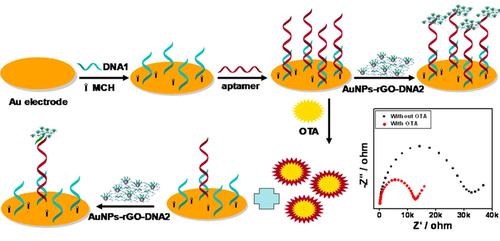当前位置:
X-MOL 学术
›
Electroanalysis
›
论文详情
Our official English website, www.x-mol.net, welcomes your
feedback! (Note: you will need to create a separate account there.)
Advantages of Carbon Nanomaterials in Electrochemical Aptasensors for Food Analysis
Electroanalysis ( IF 2.7 ) Pub Date : 2017-10-24 , DOI: 10.1002/elan.201700578 Alina Vasilescu 1 , Akhtar Hayat 2 , Szilveszter Gáspár 1 , Jean-Louis Marty 3
Electroanalysis ( IF 2.7 ) Pub Date : 2017-10-24 , DOI: 10.1002/elan.201700578 Alina Vasilescu 1 , Akhtar Hayat 2 , Szilveszter Gáspár 1 , Jean-Louis Marty 3
Affiliation

|
Electrochemical aptasensors appear as promising tools in food analysis, able to provide sensitive, fast and cost-effective analysis, with the added advantage of portability. Carbon nanomaterials and in particular carbon nanotubes and graphene are among the nanomaterials most often used to build electrochemical aptasensors due to their good electrical conductivity, large surface area and multiple functionalisation possibilities. This review aims to give an overview of the types of carbon nanomaterials and their composites which have been used to enhance the performance of electrochemical aptasensors. Examples are detailed for the biosensors which were tested with real food samples. In these aptasensors, carbon nanomaterials have played different roles, from facilitating the immobilization of high amounts of aptamer and enhancing the electroactive area of the sensors to roles as nanocarrier for signaling probes in amplification schemes or even as electroactive probes generating the output signal. The survey of recent literature shows a positive evolution towards increased aptasensor testing with food samples. However, many challenges remain related to the better characterization of nanomaterials used, clarifying the roles of specific components in multi-component nanocomposites and widening the types of food matrices and analytes tested with the aptasensors. Although we are still far from knowing when these novel tools will replace classic analytical methods in food analysis, carbon nanomaterials will certainly continue to play an important role in the design of future electrochemical aptasensors for food analysis.
中文翻译:

碳纳米材料在食品分析电化学适体传感器中的优势
电化学适体传感器似乎是食品分析中很有前途的工具,能够提供灵敏、快速和经济高效的分析,并具有便携性的额外优势。碳纳米材料,特别是碳纳米管和石墨烯,由于其良好的导电性、大表面积和多种功能化的可能性,是最常用于构建电化学适体传感器的纳米材料之一。本综述旨在概述用于提高电化学适体传感器性能的碳纳米材料及其复合材料的类型。详细介绍了使用真实食物样品测试的生物传感器的示例。在这些适体传感器中,碳纳米材料发挥了不同的作用,从促进大量适体的固定和增强传感器的电活性区域到作为放大方案中信号探针的纳米载体的作用,甚至作为产生输出信号的电活性探针。近期文献调查表明,增加对食品样品进行适体传感器测试的积极进展。然而,许多挑战仍然与更好地表征所使用的纳米材料、阐明特定组分在多组分纳米复合材料中的作用以及扩大使用适体传感器测试的食物基质和分析物的类型有关。尽管我们还远未知道这些新工具何时会取代食品分析中的经典分析方法,
更新日期:2017-10-24
中文翻译:

碳纳米材料在食品分析电化学适体传感器中的优势
电化学适体传感器似乎是食品分析中很有前途的工具,能够提供灵敏、快速和经济高效的分析,并具有便携性的额外优势。碳纳米材料,特别是碳纳米管和石墨烯,由于其良好的导电性、大表面积和多种功能化的可能性,是最常用于构建电化学适体传感器的纳米材料之一。本综述旨在概述用于提高电化学适体传感器性能的碳纳米材料及其复合材料的类型。详细介绍了使用真实食物样品测试的生物传感器的示例。在这些适体传感器中,碳纳米材料发挥了不同的作用,从促进大量适体的固定和增强传感器的电活性区域到作为放大方案中信号探针的纳米载体的作用,甚至作为产生输出信号的电活性探针。近期文献调查表明,增加对食品样品进行适体传感器测试的积极进展。然而,许多挑战仍然与更好地表征所使用的纳米材料、阐明特定组分在多组分纳米复合材料中的作用以及扩大使用适体传感器测试的食物基质和分析物的类型有关。尽管我们还远未知道这些新工具何时会取代食品分析中的经典分析方法,











































 京公网安备 11010802027423号
京公网安备 11010802027423号